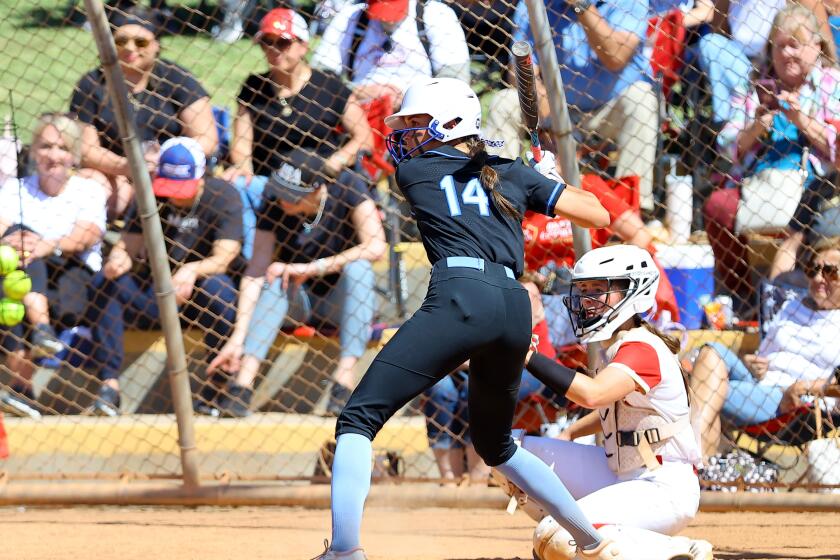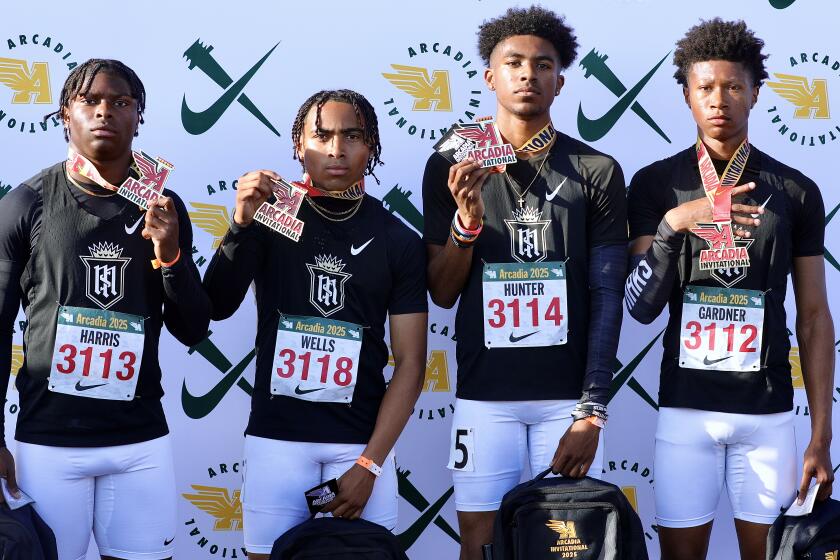Slow Pitch Veteran : Former Angel Tanana Counts His Blessings, Waits for Better Days
- Share via
SAN DIEGO — It has been 15 years since Frank Tanana’s fastball could keep up with Sunday morning freeway traffic, but somehow he remains upwardly mobile. While the rest of the New York Mets are facing some St. Bernard-size dog days in August and September, Tanana figures to be spinning rainbow curves for a pennant contender.
Saturday, he improved his stock with the teams near the top of the standings when he held San Francisco without a hit until Barry Bonds homered with two outs in the seventh inning. It was the closest he has come to a no-hitter in 20 major league seasons.
Tanana, who struck out more batters than Nolan Ryan in 1975, doesn’t make hitters look like John Kruk facing Randy Johnson anymore. Batters fear only losing concentration while awaiting the arrival of another changeup. He has more speeds than a mountain bike, but they’re all low gears: slow, slower, slower still, slowest.
“The funny thing is, it was his fastball against the Giants,” Met Manager Dallas Green said. “He had great command of his fastball, and when he has that, the rest of his stuff just falls in line. They can’t sit and wait for him to make a mistake with the slow stuff.
“He used the slow stuff well, too, but he got a lot of outs off the fastball, jamming guys and keeping them off balance. And it’s not like he was pitching against Little Sisters of the Poor. That’s a pretty good offensive team, and he just shut them down.”
It just goes to show how far you can get with a 77-m.p.h. fastball, says teammate Dwight Gooden. “Man, I thought he was going to get it. I really did,” Gooden said.
Gooden and Green better enjoy watching hitters twist in Tanana’s wind while they can. The Mets signed free-agent Tanana this spring primarily to be a role model and mentor for their young starting pitchers as they made their drive for the NL East title.
Thirty games out in July pretty much sidetracks that scenario.
“That plan is past,” Green said. “A lot of things are past us now. (A trade) would make a lot of sense. Frank knows that the contributions he can make at this point in his career are best suited to a pennant-contending team. Obviously, we can’t offer him much in that regard, and if we’re going to start looking to the future, which we probably will do very soon, Frank is not part of that future.”
But then who would’ve figured Tanana would be part of anybody’s future in 1993?
*
Tanana’s earned-run average (4.78) is worse than that of tormented teammate Anthony Young--of 0-12 infamy--and his record is just 5-8. The man who once pitched 14 consecutive complete games for the Angels doesn’t go the distance anymore. Still, the 39-year-old left-hander remains a viable commodity.
The Mets figure to come out of the deal with no more than a prospect, but Tanana also believes it’s the right move for all parties.
“If you’re on a bad ballclub and you’re not exactly a pup, they’re not going to look to you for the future,” he said. “This ballclub is at rock bottom and with my experience, I could help a good team. But there’s not a whole lot I can do for a bad ballclub.
“In a sense, the idea of being traded to a contender is exciting, but I can’t dwell on that. I’m very loyal to the people who pay me, and at this point in time, that’s the Texas . . . not the Texas Rangers, the New York Mets, and I’m trying to help them be the best team they can be.”
You’ll have to excuse Tanana if his head is twirling like one of his curveballs. He hasn’t pitched for the Rangers since 1985, but who knows? He could be back in Arlington any day now.
“When the day comes, and I don’t doubt that it will, that I’m on another ballclub, then we’ll close the book on this chapter and start a new one,” he said. “It’s going to happen, and I would imagine it would happen soon, but I have no say in the matter, so there’s no use worrying about it.”
Worrying, of course, is not really the right choice of words. Relishing is a better fit. This is a man who knows everything about pitching for bad teams.
After all, he pitched eight seasons for the Angels.
“Good pitchers on winning teams are 20-10, and good pitchers on losing teams are 10-20,” he said. “Interchange the pitchers, and you’ll interchange their records.”
Tanana has never won 20 games. He was 19-10 with the Angels in 1976 and lost a victory after taking an 8-0 lead into the ninth inning against the Yankees on Aug. 22. (“It was 8-8 before I could even ice down,” he says.)
“The only reason I won with the Angels was because I dominated,” he said. “I was as good as there was in the game. I would’ve been winning 25 games a year on a good team.”
*
There are many not-so-fond memories of the good, old days and much he’s not proud of during his reign as baseball’s premier playboy pitcher.
After a victory on his birthday, he told reporters he planned on getting “smoked out of my gourd.”
“You’re young and living for the moment, and you don’t get interested in preserving what you have until it’s taken away from you,” he said. “It’s sad to say, but that’s what it takes for most young guys in this game to begin to take care of themselves and treasure what they’ve got, to realize how precious and valuable a career in the big leagues is.
“Some just blow it out, ruin their careers, even their lives, because of their inattentiveness to preserve and improve what they have.”
For Tanana, the realization came in two devastating emotional blows. He suffered his first serious arm injury in 1977--an inflamed elbow tendon that meant he had thrown his last 90 m.p.h. fastball--and in 1978, teammate Lyman Bostock was murdered.
“Both events had a profound effect on my life,” Tanana said. “I believed in eternal life, I wanted to go to heaven, and the death of Lyman made me think, ‘Hey Frank, tomorrow it could be you.’ And the sore arm, now I look back at the injury and I’m thankful for it. It led me to Christ and changed my life.”
It also altered his pitching style, although he throws the same three pitches--fastball, curveball, changeup. He now throws from a myriad of arm angles as well as varying speeds, and when he gets the ball on or near the perimeter of the strike zone, he still can be very effective.
That hasn’t been the case often this season, but Tanana thinks he may be slipping into a groove.
“I’ve been mediocre,” he said. “I haven’t been as consistent as I’d like, but I’m throwing it much better now than I was earlier in the year. Overall, maybe I’d give myself a ‘C.’ ”
And in this game, a left-handed ‘C’ can be enough to earn a promotion to the head of the standings.
Frank Tanana in the Majors
Year Team W-L ERA G GS IP H R ER BB SO 1973 Angels 2-2 3.12 4 4 26.0 20 11 9 8 22 1974 Angels 14-19 3.11 39 35 268.2 262 104 93 77 180 1975 Angels 16-9 2.63 34 33 257.1 211 80 75 73 269 1976 Angels 19-10 2.44 34 34 288.1 212 88 78 73 261 1977 Angels 15-9 2.54 31 31 241.1 201 72 68 61 205 1978 Angels 18-12 3.65 33 33 239.0 239 108 97 60 137 1979 Angels 7-5 3.90 18 17 90.1 93 44 39 25 46 1980 Angels 11-12 4.15 32 31 204.0 223 107 94 45 113 1981 Boston 4-10 4.02 24 23 141.1 142 70 63 43 78 1982 Texas 7-18 4.21 30 30 194.1 199 102 91 55 87 1983 Texas 7-9 3.16 29 22 159.1 144 70 56 49 108 1984 Texas 15-15 3.25 35 35 246.1 234 117 89 81 141 1985 Texas 2-7 5.91 13 13 77.2 89 53 51 23 52 Detroit 10-7 3.34 20 20 137.1 131 59 51 34 107 1986 Detroit 12-9 4.16 32 31 188.1 196 95 87 65 119 1987 Detroit 15-10 3.91 34 34 218.2 216 106 95 56 146 1988 Detroit 14-11 4.21 32 32 203.0 213 105 95 64 127 1989 Detroit 10-14 3.58 33 33 223.2 227 105 89 74 147 1990 Detroit 9-8 5.31 34 29 176.1 190 104 104 66 114 1991 Detroit 13-12 3.77 33 33 217.1 217 98 91 78 107 1992 Detroit 13-11 4.39 32 31 186.2 188 102 91 90 91 1993 N.Y. Mets 5-8 4.78 18 18 107.1 129 66 57 38 63
More to Read
Go beyond the scoreboard
Get the latest on L.A.'s teams in the daily Sports Report newsletter.
You may occasionally receive promotional content from the Los Angeles Times.










